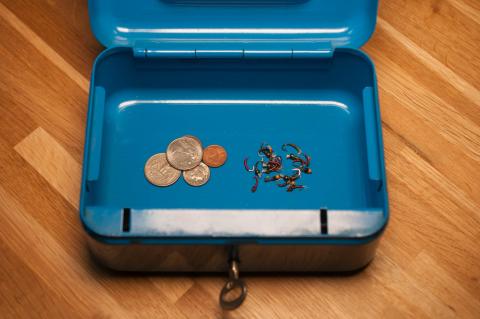Recent comments
Florin,
I'm sorry, but I have to say that I have no idea which one to choose. I don't know any of the lines or the rod. I can see that it's a full line and a shooting head, and my only comment is that I'd probably choose the shooting head myself for my ordinary fishing and the full line if I was looking for a slightly better presentation. And I'd go for the slow intermediate in both cases.
Hope this helps just a bit.
Martin
- Log in to post comments
This whole fly/photo challenge is a great idea, and my best wishes for a speedy recovery for Mr./Mrs Hise.
- Log in to post comments
A friend of mine discovered this trick--Kleenex!! Yes-- wipe down a fish slimed cdc fly thoroughly with a small wad of Kleenex.it will float like a cork! Do NOT ever use liquid flotants OR dry desiccants. dry cdc doesn't need it.
- Log in to post comments
I am back to tying leaders. It helps me relax.
- Log in to post comments
Greeting Martin!
Really useful article. I want your opinion about 2 lines and the rod.
http://www.guideline.no/Coastal.d2Y-18UlNO38pBp7q5B8Nxh0xE2N13PYpwtrI4p…
or
http://www.guideline.no/?module=Webshop;action=ProductGroup.publicOpen;…
and the rod
http://www.scierra.com/rods/srxv2/
all #6 class.
I hope you will reply soon and thank you for your time.
- Log in to post comments
Try Amazon for bulk felting needle purchases. I'm just getting started with tube flies and ran across the article while researching materials and techniques. If you tie on a Norvise as I do, there are a couple of instructional videos by Norm that address the problems of tube slippage.
- Log in to post comments
Well if you don't fully cure it then it could. Using a low powered light with a short cure time will keep it tacky, however if you use their light, it will cure quickly and without tackyness as they advertise. Depending on the formula, it can cure tack free in as little as 8 seconds. The thicker the formula though the longer it takes. The thick hard formula takes 30+ seconds. I usually cure it to keep it from moving then stick it in the sun to finish. But the rest of their formulas are much quicker.
- Log in to post comments
David is a Good tier and a poor communicator. Extremely difficult to understand, I speak English, his voice Trails off and he has a tendency to mumble. Fortunately one can visually see his tying steps but it's almost impossible to hear what he is saying.
The above is meant as feedback if he cares. Speaking up, more clearly and no mumbling would be a huge improvement. Especially for those of us that don't share his dialect.
- Log in to post comments
I made one of these rod Tubes For my Three Piece Fly Rod.I'm not paying a big price for a ROD TUBE? when there so easy to make
- Log in to post comments
I have used nothing but homemade/handmade tapered leaders my entire life, growing up in western Maine, fly fishing has always been a large part of my life, and economically it just makes sense, and the transfer of energy through the cast can actually be felt as the leader unfurls, nailknots and homemade leaders are the way to go, i just like whipping them up every spring and handing them out to family and friends who lack the patience to do it themselves. 5 minutes and total cost with mono about 11 cents per 10 footer, or tapered factory extruded 3-7 dollars, with greatly varying quality/strength, using Maxima Chameleon for the entire leader, (tannin rich coffee clored waters) it has yet to let me down, so if you got the dough go with what you want, but if youre a bit more frugal like myself, build them yourself, there are hundreds of formulas through LeaderCalc right here on site that are the best around, I cant say enough about the quality of info here, again thank you and as always "tight lines and big smiles".
- Log in to post comments
Thanks Martin for the reply and the link on Leader formula. A Question remains . In my 6X WF-F line I choose a choose a 4X or 5X tippet ? So I choose a similar rated Leader i.e. 4X / 5X. Or, my Weight 6 WF-F Line is to be matched with 4/5X Leader to which I may install a 4/5 X Tippet depending on the fly size. Will the Fly size influence the tippet (as explained in the link) but also the leader ? Do we have a Fly Line/Leader/ Tippet/ Fly ratio formula too ?
- Log in to post comments
Trevor "McTage" Tanner has designed some killer carp patterns in addition to the trouser worm. For me, the mcluvin and chubby chaser have yielded the best results. give any of his patterns a try and you will be pleased.
- Log in to post comments
Ashok,
You considerations makes a lot of sense and you seem to be on the right path already as far as I can see.
Regarding the line weight: yes, it's not a bad idea to use a line one class heavier than what the rod is made for, particularly when you are a beginner. It makes it easier to cast a shorter line, and modern rods can handle it with no problems. Once you master the casting, you can consider going down in line weight.
Regarding the tippet and leader, you start selecting the tippet. I never heard of your form, but it seems to make good sense. On this page http://globalflyfisher.com/leaders/formulas you will find a list (table 2) that might also help you. Tippet thickness depends on fly size and how spooky your fish are. It also depends on the conditions and the strength of fish and current. Too thin a tippet for strong and large fish makes little sense. They will simply break you off. Luckily strong current also makes the need for long and thin tippets less, simply because the turbulence helps to hide the line.
Once you have selected a tippet, buy or tie a leader to match - ending in the tippet size or one size thicker. A 7'-9' leader will probably be good in your case. It should be manageable, but still long enough to do some decently stealthy presentations. Tie a 2-3' tippet to that and you will be fine.
I hope this helps you.
Martin
- Log in to post comments
I am just starting to Fly fish in India for Trout and small Mahseer. For the same I plan to buy a 4 piece 8'-6" (Line weight 5) and a Reel rated 5/6. To this I plan spool 20 lbs/ 100 yds of backing, WF-F 6 (I have been told to use 1 size heavier ?), and a 9' leader and Tippet. The problem is I don't know how to match the correct Leader / Tippet (in context to WF-F 5/6 Line) while keeping in mind the size range of Nymphs (mainly) and a few Dry Flies to be used. I am assuming they will be mainly #12/14 for trout and a few #6 for Mahseer.
Please advice on the correct way to choose the Leader and the Tippet. I have read somewhere that the Tippet should be chosen by dividing the Fly size by 3 viz. a #12 Fly/Nymph will have a 4X Tippet.
- Log in to post comments
I am still using Fly Source on a mchine running Windows 10. I have over 4500 patterns in it right now. I have tried sending the exe file, but none of my friends have been able to get it to install. Really a shame, right now I am saving the files as pdf's and putting them in Dropbox for Larry Leight. Just trying to make sure the patterns survive for future generations of tyers.
- Log in to post comments
Radical technique with the UV resin and poly/antron bubble. I will be utilizing that myself to represent the shortfin squid found all along the coast of Maine from May/Oct. Thanks a million for the great tech.
- Log in to post comments
I personally enjoy tying and fishing Czech/Polish nymphs,mostly in early spring when the waters in my great state of Maine are usually high and off colored, also took my "high stick" game to the next level,as always thanks again for being a great source of fly fishing/tying information,this site has helped mtself and many others step up their individual skills,keep it up guys.
- Log in to post comments
I have been using the downloadable version for years, and I am pleased to see a new version which makes simpler to use. Thank you for a fine tool.
- Log in to post comments
Bob,
Click in on our mullet articles http://globalflyfisher.com/keywords/mullet and you will see some mullet patterns somewhere in the videos and articles that list. I can recommend the Green Revenger, which is a very succesful fly here in Denmark.
http://globalflyfisher.com/pattern/green-revenger
Martin
- Log in to post comments
Jannick,
If you want the hackle to curve and sweep to the rear, the easiest way to achieve this is to tie it in on your side, tip to the rear, curved side out (towards yourself), and then start wrapping over the hook (away from yourself). This will make the fibers fall naturally towards the rear of the fly as you want it in a wet fly like this.
If you tie it in curved side in or wrap it the opposite way, it will have a tendency to stand our more perpendicular to the hook shank, which might be wanted sometimes (like in a Woolly Worm), but not in a more traditional wet fly.
Martin
- Log in to post comments
I have a question about the tying technique. Why tie in the hackle stem with the curved side out? Won't the natural bend in the barbs end up pointing the wrong way? Am I completely clueless here?
- Log in to post comments

